Area: 5.712 km²
Population: 10.018.735 (2000)
Traffic Code: 34
Population: 10.018.735 (2000)
Traffic Code: 34
The god and human, nature and art are together in there, they have created such a perfect place that it is valuable to see." Lamartine’s famous poetic line reveals his love for İstanbul, describing the embracing of two continents, with one arm reaching out to Asia and the other to Europe.
İstanbul, once known as the capital of capital cities, has many unique features. It is the only city in the world to straddle two continents, and the only one to have been a capital during two consecutive empires - Christian and Islamic. Once was capital of the Ottoman Empire, İstanbul still remains the commercial, historical and cultural pulse of Turkey, and its beauty lies in its ability to embrace its contradictions. Ancient and modern, religious and secular, Asia and Europe, mystical and earthly all co-exist here.
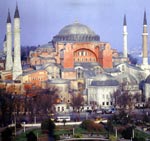
Its variety is one of İstanbul’s greatest attractions: The ancient mosques, palaces, museums and bazaars reflect its diverse history. The thriving shopping area of Taksim buzzes with life and entertainment. And the serene beauty of the İstanbul strait, Princes Islands and parks bring a touch of peace to the otherwise chaotic metropolis.
Districts
Adalar, Avcılar, Bağcılar, Bahçelievler, Bakırköy, Beşiktaş, Bayrampaşa, Beykoz, Beyoğlu, Eminönü, Eyüb, Fatih, Gaziosmanpaşa, Kadıköy, Kâğıthane, Kartal, Küçükçekmece, Pendik, Sarıyer, Şişli, Ümraniye, Üsküdar, Zeytinburnu, Büyükçekmece, Çatalca, Silivri, Şile, Esenler, Güngören, Maltepe, Sultanbeyli, and Tuzla.
The İstanbul strait
İstanbul, once known as the capital of capital cities, has many unique features. It is the only city in the world to straddle two continents, and the only one to have been a capital during two consecutive empires - Christian and Islamic. Once was capital of the Ottoman Empire, İstanbul still remains the commercial, historical and cultural pulse of Turkey, and its beauty lies in its ability to embrace its contradictions. Ancient and modern, religious and secular, Asia and Europe, mystical and earthly all co-exist here.

Its variety is one of İstanbul’s greatest attractions: The ancient mosques, palaces, museums and bazaars reflect its diverse history. The thriving shopping area of Taksim buzzes with life and entertainment. And the serene beauty of the İstanbul strait, Princes Islands and parks bring a touch of peace to the otherwise chaotic metropolis.
Districts
Adalar, Avcılar, Bağcılar, Bahçelievler, Bakırköy, Beşiktaş, Bayrampaşa, Beykoz, Beyoğlu, Eminönü, Eyüb, Fatih, Gaziosmanpaşa, Kadıköy, Kâğıthane, Kartal, Küçükçekmece, Pendik, Sarıyer, Şişli, Ümraniye, Üsküdar, Zeytinburnu, Büyükçekmece, Çatalca, Silivri, Şile, Esenler, Güngören, Maltepe, Sultanbeyli, and Tuzla.
The İstanbul strait
Golden Horn: This horn-shaped estuary divides European İstanbul. One of the best natural harbours in the world, it was once the centre for the Byzantine and Ottoman navies and commercial shipping interests. Today, attractive parks and promenades line the shores, a picturesque scene especially as the sun goes down over the water. At Fener and Balat, neighbourhoods midway up the Golden Horn, there are entire streets filled with old wooden houses, churches, and synagogues dating from Byzantine and Ottoman times. The Orthodox Patriarchy resides at Fener and a little further up the Golden Horn at Eyup, are some wonderful examples of Ottoman architecture. Muslim pilgrims from all over the world visit Eyup Mosgue and Tomb of Eyup, the Prophet Mohammed’s standard bearer, and it is one of the holiest places in Islam. The area is a still a popular burial place, and the hills above the mosque are dotted with modern gravestones interspersed with ornate Ottoman stones. The Pierre Loti Cafe, at the top of hill overlooking the shrine and the Golden Horn, is a wonderful place to enjoy the tranquility of the view.Beyoğlu and Taksim: Beyoğlu is an interesting example of a district with European-influenced architecture, from a century before. Europe’s second oldest subway, Tunel was built by the French in 1875, must be also one of the shortest – offering a one-stop ride to start of Taksim. Near to Tunel is the Galata district, whose Galata Tower became a famous symbols of İstanbul, and the top of which offers a tremendous 180 degree view of the city.
From the Tunel area to Taksim square, is one of the city’s focal points for shopping, entertainment and urban promenading: İstiklal Caddesi is a fine example of the contrasts and compositions of İstanbul; fashion shops, bookshops, cinemas, markets, restaurants and even hand-carts selling trinkets and simit (sesame bread snack) ensure that the street is packed throughout the day until late into the night. The old tramcars re-entered into service, which shuttle up and down this fascinating street, and otherwise the street is entirely pedestrianised. There are old embassy buildings, Galatasaray High School, the colourful ambience of Balık Pazarı (Fish Bazaar) and restaurants in Çiçek Pasaji (Flower Passage). Also on this street is the oldest church in the area, St Mary’s Draperis dating back to 1789, and the Franciscan Church of St Antoine, demolished and then rebuilt in 1913.
The street ends at Taksim Square, a big open plaza, the hub of modern İstanbul and always crowded, crowned with an imposing monument celebrating Ataturk and the War of Independence. The main terminal of the new subway is under the square, adjacent is a noisy bus terminal, and at the north end is the Ataturk Cultural Centre, one of the venues of the İstanbul Theatre Festival. Several five-star hotels are dotted around this area, like the Hyatt, Intercontinental and Hilton (the oldest of its kind in the city). North of the square is the İstanbul Military Museum.
Taksim and Beyoğlu have for centuries been the centre of nightlife, and now there are many lovely bars and clubs off Istiklal Cadesi, including some of the only gay venues in the city. Beyoğlu is also at the centre of the more bohemian arts scene.
Sultanahmet: Many places of tourist interest are concentrated in Sultanahmet, in heart of the Imperial Centre of the Ottoman Empire. The most important places in this area, all of which are described in detail in the “Places of Interest” section, are Topkapı Palace, Aya Sofya, Sultanahmet Mosgue (the Blue Mosque), the Hippodrome, Kapalı Carşı (Covered Market), Yerebatan Sarnıcı and the Museum of Islamic Art.
In addition to this wonderful selection of historical and architectural sites, Sultanahmet also has a large concentration of carpet and souvenir shops, hotels and guesthouses, cafes, bars and restaurants, and travel agents.
Ortaköy: Ortakoy was a resort for the Ottoman rulers because of its attractive location on the İstanbul strait, and is still a popular spot for residents and visitors. The village is within a triangle of a mosque, church and synagogue, and is near çirağan Palace, Kabataş High School, Feriye, Princess Hotel.
The name Ortaköy reflects the university students and teachers who would gather to drink tea and discuss life, when it was just a small fishing village. These days, however, that scene has developed into a suburb with an increasing amount of expensive restaurants, bars, shops and a huge market. The fishing, however, lives on and the area is popular with local anglers, and there is now a huge waterfront tea-house which is crammed at weekends and holidays.
Sarıyer: The first sight of Sarıyer is where the İstanbul strait connects with the Black Sea, after the bend in the river after Tarabya. Around this area, old summer houses, embassies and fish restaurants line the river, and a narrow road which separates it from Büyükdere, continues along to the beaches of Kilyos.
Sarıyer and Rumeli Kavağı are the final wharfs along the European side visited by the İstanbul strait boat trips. Both these districts, famous for their fish restaurants along with Anadolu Kavagı, get very crowded at weekends and holidays with İstanbul residents escaping the city.
After these points, the İstanbul strait is lined with tree-covered cliffs and little habitation. The Sadberk Hanım Museum, just before Sariyer, is an interesting place to visit; a collection of archaeological and ethnographic items, housed in two wooden houses. A few kilometres away is the huge Belgrade Forest, once a haunting ground of the Ottomans, and now a popular weekend retreat into the largest forest area in the city.
Üsküdar: Relatively unknown to tourists, the suburb of Üsküdar, on the Asian side of the İstanbul strait, is one of the most attractive suburbs. Religiously conservative in its background, it has a tranquil atmosphere and some fine examples of imperial and domestic architecture.
The iskele, or Mihrimah Mosgue is opposite the main ferry pier, on a high platform with a big covered porch in front, often occupied by older local men watching life around them. Opposite this is Yeni Valide Mosgue, built in 1710, and the Valide Sultan’s green tomb rather like a giant birdcage. The Çinili Mosque takes its name from the beautiful tiles which decorate the interior, and was built in 1640.
Apart from places of religious interest, Üsküdar is also well known as a shopping area, with old market streets selling traditional local products, and a good fleamarket with second hand furniture. There are plenty of good restaurants and cafes with a great views of the İstanbul strait and the rest of the city, along the quayside. In the direction of Haydarpaşa is the Karaca Ahmet Cemetery, which is the largest Muslim graveyard in İstanbul. The front of the Çamlıca hills lie at the ridge of area and also offer great panoramic views of the islands and river.
Kadıköy: Further down to the south along, the İstanbul strait towards the Marmara sea, Kadıköy has developed into a lively area with up-market shopping, eating and entertainment making it popular especially with wealthy locals. Once prominent in the history of Christianity, the 5th century hosted important consul meetings here, but there are few reminders of that age. It is one of the improved districts of İstanbul over the last century, and fashionable area to promenade along the waterfront in the evenings, especially around the marinas and yacht clubs.
Bağdat Caddesi is one of the most trendy – and label-conscious – fashion shopping streets, and for more down-to-earth goods, the Gen Azim Gündüz Caddesi is the best place for clothes, and the bit pazari on Ozelellik Sokak is good for browsing through junk. The Benadam art gallery remains in Moda district with many other foreing cusines, restaurants and cafes.
Haydarpaşa: To the north of Kadikoy is Haydarpasa, and the train station built in 1908 with Prussian-style architecture which was the first stop along the Baghdad railway. Now it is the main station going to eastbound destinations both within Turkey, and international. There are tombs and monuments dedicated to the English and French soldiers who lost their lives during the Crimean War (1854-56), near the military hospital. The north-west wing of the 19th Century Selimiye Barracks once housed the hospital, used by Florence Nightingale to care for soldiers, and remains to honour her memory.
Polonezköy: Polonezköy, although still within the city, is 25 km. away from the centre and not easy to reach by public transport. Translated as “village of the Poles”, the village has a fascinating history: It was established in 1848 by Prince Czartorisky, leader of the Polish nationals who was granted exile in the Ottoman Empire to escape oppression in the Balkans. During his exile, he succeeded in establishing a community of Balkans, which still survives, on the plot of land sold to him by a local monastery.
Since the 1970s the village has become a popular place with local İstanbulites, who buy their pig meat there (pig being forbidden under Islamic law and therefore difficult to get elsewhere). All the Poles have since left the village, and the place is inhabited now by wealthy city people, living in the few remaining Central European style wooden houses with pretty balconies.
What attracts most visitors to Polonezkoy is its vast green expanse, which was designated İstanbul’s first national park, and the walks though forests with streams and wooden bridges. Because of its popularity, it gets crowded at weekends and the hotels are usually full.
Kilyos: Kilyos is the nearest beach resort to the city, on the Black Sea coast on the European side of the İstanbul strait. Once a Greek fishing village, it has quickly been developed as a holiday-home development, and gets very crowded in summer. Because of its ease to get there, 25km and plenty of public transport, it is good for a day trip, and is a popular weekend getaway with plenty of hotels, and a couple of campsites.
Şile: A pleasant, small holiday town, Şile lies 50km from Üsküdar on the Black Sea coast and some people even live there and commute into İstanbul. The white sandy beaches are easily accessible from the main highway, lying on the west, as well as a series of small beaches at the east end. The town itself if perched on a clifftop over looking the bay tiny island. There is an interesting French-built black-and-white striped lighthouse, and 14th century Genoese castle on the nearby island. Apart from its popular beaches, the town is also famous for its craft; Şile bezi, a white muslin fabric a little like cheesecloth, which the local women embroider and sell their products on the street, as well as all over Turkey.
The town has plenty of accommodation available, hotels, guest houses and pensions, although can get very crowded at weekends and holidays as it is very popular with people from İstanbul for a getaway, especially in the summer. There are small restaurants and bars in the town.
Prince’s Islands: Also known as İstanbul Islands, there are eight within one hour from the city, in the Marmara Sea. Boats ply the islands from Sirkeci, Kabataş and Bostancı, with more services during the summer. These islands, on which monasteries were established during the Byzantine period, was a popular summer retreat for palace officials. It is still a popular escape from the city, with wealthier owning summer houses.
Büyükada The largest and most popular one in İstanbul is Büyükada (the Great Island). Large wooden mansions still remain from the 19th century when wealthy Greek and Armenian bankers built them as a holiday villas. The island has always been a place predominantly inhabited by minorities.
Buyukada has long had a history of people coming here in exile or retreat; its most famous guest being Leon Trotsky, who stayed for four years writing ‘The History of the Russian Revolution’. The monastery of St George also played host to the granddaughter of Empress Irene, and the royal princess Zoe, in 1012.
The island consists of two hills, both surmounted by monasteries, with a valley between. Motor vehicles are banned, so getting around the island can be done by graceful horse and carriage, leaving from the main square off Isa Celebi Sokak. Bicycles can also be hired.
The southern hill, Yule Tepe, is the quieter of the two and also home of St George’s Monastery. It consists of a series of chapels on three levels, the site of which is a building dating back to the 12th century. In Byzantine times it was used as an asylum, with iron rings on the church floors used to restrain patients. On the northern hill is the monastery İsa Tepe, a 19th century house.
The entire island is lively and colourful, with many restaurants, hotels, tea houses and shops. There are very big well-kept houses, trim gardens, and pine groves, as well as plenty of beach and picnic areas.
Burgazada It is a smaller and less infrastructured for tourists.The famous Turkish novelist, Sait Faik Abasıyanık lived there, and his house has been turned into a museum dedicated to his work, and retains a remarkable tranquil and hallowed atmosphere.
Heybeliada ‘Island of the Saddlebag’, because of its shape, is loved for its natural beauty and beaches. It also has a highly prestigious and fashionable watersports club in the northwest of the island. One of its best-known landmarks is the Greek Orthodox School of Theology, with an important collection of Byzantine manuscripts. The school sits loftily on the northern hill, but permission is needed to enter, from the Greek Orthodox Patriarchate in Fener. The Deniz Harp Okulu, the Naval High School, is on the east side of the waterfront near the jetty, which was originally the Naval War Academy set up in 1852, then a high school since 1985. Walking and cycling are popular here, plus isolated beaches as well as the public Yöruk Beach, set in a magnificent bay.
There are plenty of good local restaurants and tea houses, especially along Ayyıldız Caddesi, and the atmosphere is one of a close community.
Environment: Wide beaches of Kilyos at European side of Black Sea at 25th km. outside the İstanbul, is attracting İstanbul residents during summer months. Belgrad Forest, inside from Black Sea, at European Side is the widest forest around İstanbul. İstanbul residents, at week ends, come here for family picnic with brazier at its shadows. 7 old water tank and some natural resources in the region compose a different atmosphere. Moğlova Aqueduct, which is constructed by Mimar Sinan during 16th century among Ottoman aqueducts, is the greatest one. 800 m. long Sultan Süleyman Aqueduct, which is passing over Golf Club, and also a piece of art of Mimar Sinan is one of the longest aqueducts within Turkey.Polonezköy, which is 25 km. away from İstanbul, is founded at Asia coast during 19th century by Polish immigrants. Polonezköy, for walking in village atmosphere, travels by horse, and tasting traditional Polish meals served by relatives of initial settlers, is the resort point of İstanbul residents. Beaches, restaurants and hotels of Şile at Black Sea coast and 70 km. away from Üsküdar, are turning this place into one of the most cute holiday places of İstanbul. Region which is popular in connection with tourism, is the place where famous Şile cloth is produced.
Bayramoğlu - Darıca Bird Paradise and Botanic Park is a unique resort place 38 km. away from İstanbul. This gargantuan park with its trekking roads, restaurants is full of bird species and plants, coming from various parts of the world.
Sweet Eskihisar fisherman borough, to whose marina can be anchored by yachtsmen after daily voyages in Marmara Sea is at south east of İstanbul. Turkey's 19th century famous painter, Osman Hamdi Bey's house in borough is turned into a museum. Hannibal's tomb between Eskihisar and Gebze is one of the sites around a Byzantium castle.
There are lots of İstanbul residents' summer houses in popular holiday place 65 km. away from İstanbul, Silivri. This is a huge holiday place with magnificent restaurants, sports and health centers. Conference center is also attracting businessmen, who are escaping rapid tempo of urban life for "cultural tourism" and business - holiday mixed activities. Scheduled sea bus service is connecting İstanbul to Silivri.
Islands within Marmara Sea, which is adorned with nine islands, was the banishing place of the Byzantium princes. Today they are now wealthy İstanbul residents' escaping places for cool winds during summer months and 19th century smart houses. Biggest one of the islands is Büyükada. You can have a marvelous phaeton travel between pine trees or have a swim within one of the numerous bays around islands!
Other popular islands are Kınalı, Sedef, Burgaz and Heybeliada. Regular ferry voyages are connecting islands to both Europe and Asia coasts. There is a rapid sea bus service from Kabataş during summers.
From the Tunel area to Taksim square, is one of the city’s focal points for shopping, entertainment and urban promenading: İstiklal Caddesi is a fine example of the contrasts and compositions of İstanbul; fashion shops, bookshops, cinemas, markets, restaurants and even hand-carts selling trinkets and simit (sesame bread snack) ensure that the street is packed throughout the day until late into the night. The old tramcars re-entered into service, which shuttle up and down this fascinating street, and otherwise the street is entirely pedestrianised. There are old embassy buildings, Galatasaray High School, the colourful ambience of Balık Pazarı (Fish Bazaar) and restaurants in Çiçek Pasaji (Flower Passage). Also on this street is the oldest church in the area, St Mary’s Draperis dating back to 1789, and the Franciscan Church of St Antoine, demolished and then rebuilt in 1913.
The street ends at Taksim Square, a big open plaza, the hub of modern İstanbul and always crowded, crowned with an imposing monument celebrating Ataturk and the War of Independence. The main terminal of the new subway is under the square, adjacent is a noisy bus terminal, and at the north end is the Ataturk Cultural Centre, one of the venues of the İstanbul Theatre Festival. Several five-star hotels are dotted around this area, like the Hyatt, Intercontinental and Hilton (the oldest of its kind in the city). North of the square is the İstanbul Military Museum.
Taksim and Beyoğlu have for centuries been the centre of nightlife, and now there are many lovely bars and clubs off Istiklal Cadesi, including some of the only gay venues in the city. Beyoğlu is also at the centre of the more bohemian arts scene.
Sultanahmet: Many places of tourist interest are concentrated in Sultanahmet, in heart of the Imperial Centre of the Ottoman Empire. The most important places in this area, all of which are described in detail in the “Places of Interest” section, are Topkapı Palace, Aya Sofya, Sultanahmet Mosgue (the Blue Mosque), the Hippodrome, Kapalı Carşı (Covered Market), Yerebatan Sarnıcı and the Museum of Islamic Art.
In addition to this wonderful selection of historical and architectural sites, Sultanahmet also has a large concentration of carpet and souvenir shops, hotels and guesthouses, cafes, bars and restaurants, and travel agents.
Ortaköy: Ortakoy was a resort for the Ottoman rulers because of its attractive location on the İstanbul strait, and is still a popular spot for residents and visitors. The village is within a triangle of a mosque, church and synagogue, and is near çirağan Palace, Kabataş High School, Feriye, Princess Hotel.
The name Ortaköy reflects the university students and teachers who would gather to drink tea and discuss life, when it was just a small fishing village. These days, however, that scene has developed into a suburb with an increasing amount of expensive restaurants, bars, shops and a huge market. The fishing, however, lives on and the area is popular with local anglers, and there is now a huge waterfront tea-house which is crammed at weekends and holidays.
Sarıyer: The first sight of Sarıyer is where the İstanbul strait connects with the Black Sea, after the bend in the river after Tarabya. Around this area, old summer houses, embassies and fish restaurants line the river, and a narrow road which separates it from Büyükdere, continues along to the beaches of Kilyos.
Sarıyer and Rumeli Kavağı are the final wharfs along the European side visited by the İstanbul strait boat trips. Both these districts, famous for their fish restaurants along with Anadolu Kavagı, get very crowded at weekends and holidays with İstanbul residents escaping the city.
After these points, the İstanbul strait is lined with tree-covered cliffs and little habitation. The Sadberk Hanım Museum, just before Sariyer, is an interesting place to visit; a collection of archaeological and ethnographic items, housed in two wooden houses. A few kilometres away is the huge Belgrade Forest, once a haunting ground of the Ottomans, and now a popular weekend retreat into the largest forest area in the city.
Üsküdar: Relatively unknown to tourists, the suburb of Üsküdar, on the Asian side of the İstanbul strait, is one of the most attractive suburbs. Religiously conservative in its background, it has a tranquil atmosphere and some fine examples of imperial and domestic architecture.
The iskele, or Mihrimah Mosgue is opposite the main ferry pier, on a high platform with a big covered porch in front, often occupied by older local men watching life around them. Opposite this is Yeni Valide Mosgue, built in 1710, and the Valide Sultan’s green tomb rather like a giant birdcage. The Çinili Mosque takes its name from the beautiful tiles which decorate the interior, and was built in 1640.
Apart from places of religious interest, Üsküdar is also well known as a shopping area, with old market streets selling traditional local products, and a good fleamarket with second hand furniture. There are plenty of good restaurants and cafes with a great views of the İstanbul strait and the rest of the city, along the quayside. In the direction of Haydarpaşa is the Karaca Ahmet Cemetery, which is the largest Muslim graveyard in İstanbul. The front of the Çamlıca hills lie at the ridge of area and also offer great panoramic views of the islands and river.
Kadıköy: Further down to the south along, the İstanbul strait towards the Marmara sea, Kadıköy has developed into a lively area with up-market shopping, eating and entertainment making it popular especially with wealthy locals. Once prominent in the history of Christianity, the 5th century hosted important consul meetings here, but there are few reminders of that age. It is one of the improved districts of İstanbul over the last century, and fashionable area to promenade along the waterfront in the evenings, especially around the marinas and yacht clubs.
Bağdat Caddesi is one of the most trendy – and label-conscious – fashion shopping streets, and for more down-to-earth goods, the Gen Azim Gündüz Caddesi is the best place for clothes, and the bit pazari on Ozelellik Sokak is good for browsing through junk. The Benadam art gallery remains in Moda district with many other foreing cusines, restaurants and cafes.
Haydarpaşa: To the north of Kadikoy is Haydarpasa, and the train station built in 1908 with Prussian-style architecture which was the first stop along the Baghdad railway. Now it is the main station going to eastbound destinations both within Turkey, and international. There are tombs and monuments dedicated to the English and French soldiers who lost their lives during the Crimean War (1854-56), near the military hospital. The north-west wing of the 19th Century Selimiye Barracks once housed the hospital, used by Florence Nightingale to care for soldiers, and remains to honour her memory.
Polonezköy: Polonezköy, although still within the city, is 25 km. away from the centre and not easy to reach by public transport. Translated as “village of the Poles”, the village has a fascinating history: It was established in 1848 by Prince Czartorisky, leader of the Polish nationals who was granted exile in the Ottoman Empire to escape oppression in the Balkans. During his exile, he succeeded in establishing a community of Balkans, which still survives, on the plot of land sold to him by a local monastery.
Since the 1970s the village has become a popular place with local İstanbulites, who buy their pig meat there (pig being forbidden under Islamic law and therefore difficult to get elsewhere). All the Poles have since left the village, and the place is inhabited now by wealthy city people, living in the few remaining Central European style wooden houses with pretty balconies.
What attracts most visitors to Polonezkoy is its vast green expanse, which was designated İstanbul’s first national park, and the walks though forests with streams and wooden bridges. Because of its popularity, it gets crowded at weekends and the hotels are usually full.
Kilyos: Kilyos is the nearest beach resort to the city, on the Black Sea coast on the European side of the İstanbul strait. Once a Greek fishing village, it has quickly been developed as a holiday-home development, and gets very crowded in summer. Because of its ease to get there, 25km and plenty of public transport, it is good for a day trip, and is a popular weekend getaway with plenty of hotels, and a couple of campsites.
Şile: A pleasant, small holiday town, Şile lies 50km from Üsküdar on the Black Sea coast and some people even live there and commute into İstanbul. The white sandy beaches are easily accessible from the main highway, lying on the west, as well as a series of small beaches at the east end. The town itself if perched on a clifftop over looking the bay tiny island. There is an interesting French-built black-and-white striped lighthouse, and 14th century Genoese castle on the nearby island. Apart from its popular beaches, the town is also famous for its craft; Şile bezi, a white muslin fabric a little like cheesecloth, which the local women embroider and sell their products on the street, as well as all over Turkey.
The town has plenty of accommodation available, hotels, guest houses and pensions, although can get very crowded at weekends and holidays as it is very popular with people from İstanbul for a getaway, especially in the summer. There are small restaurants and bars in the town.
Prince’s Islands: Also known as İstanbul Islands, there are eight within one hour from the city, in the Marmara Sea. Boats ply the islands from Sirkeci, Kabataş and Bostancı, with more services during the summer. These islands, on which monasteries were established during the Byzantine period, was a popular summer retreat for palace officials. It is still a popular escape from the city, with wealthier owning summer houses.
Büyükada The largest and most popular one in İstanbul is Büyükada (the Great Island). Large wooden mansions still remain from the 19th century when wealthy Greek and Armenian bankers built them as a holiday villas. The island has always been a place predominantly inhabited by minorities.
Buyukada has long had a history of people coming here in exile or retreat; its most famous guest being Leon Trotsky, who stayed for four years writing ‘The History of the Russian Revolution’. The monastery of St George also played host to the granddaughter of Empress Irene, and the royal princess Zoe, in 1012.
The island consists of two hills, both surmounted by monasteries, with a valley between. Motor vehicles are banned, so getting around the island can be done by graceful horse and carriage, leaving from the main square off Isa Celebi Sokak. Bicycles can also be hired.
The southern hill, Yule Tepe, is the quieter of the two and also home of St George’s Monastery. It consists of a series of chapels on three levels, the site of which is a building dating back to the 12th century. In Byzantine times it was used as an asylum, with iron rings on the church floors used to restrain patients. On the northern hill is the monastery İsa Tepe, a 19th century house.
The entire island is lively and colourful, with many restaurants, hotels, tea houses and shops. There are very big well-kept houses, trim gardens, and pine groves, as well as plenty of beach and picnic areas.
Burgazada It is a smaller and less infrastructured for tourists.The famous Turkish novelist, Sait Faik Abasıyanık lived there, and his house has been turned into a museum dedicated to his work, and retains a remarkable tranquil and hallowed atmosphere.
Heybeliada ‘Island of the Saddlebag’, because of its shape, is loved for its natural beauty and beaches. It also has a highly prestigious and fashionable watersports club in the northwest of the island. One of its best-known landmarks is the Greek Orthodox School of Theology, with an important collection of Byzantine manuscripts. The school sits loftily on the northern hill, but permission is needed to enter, from the Greek Orthodox Patriarchate in Fener. The Deniz Harp Okulu, the Naval High School, is on the east side of the waterfront near the jetty, which was originally the Naval War Academy set up in 1852, then a high school since 1985. Walking and cycling are popular here, plus isolated beaches as well as the public Yöruk Beach, set in a magnificent bay.
There are plenty of good local restaurants and tea houses, especially along Ayyıldız Caddesi, and the atmosphere is one of a close community.
Environment: Wide beaches of Kilyos at European side of Black Sea at 25th km. outside the İstanbul, is attracting İstanbul residents during summer months. Belgrad Forest, inside from Black Sea, at European Side is the widest forest around İstanbul. İstanbul residents, at week ends, come here for family picnic with brazier at its shadows. 7 old water tank and some natural resources in the region compose a different atmosphere. Moğlova Aqueduct, which is constructed by Mimar Sinan during 16th century among Ottoman aqueducts, is the greatest one. 800 m. long Sultan Süleyman Aqueduct, which is passing over Golf Club, and also a piece of art of Mimar Sinan is one of the longest aqueducts within Turkey.Polonezköy, which is 25 km. away from İstanbul, is founded at Asia coast during 19th century by Polish immigrants. Polonezköy, for walking in village atmosphere, travels by horse, and tasting traditional Polish meals served by relatives of initial settlers, is the resort point of İstanbul residents. Beaches, restaurants and hotels of Şile at Black Sea coast and 70 km. away from Üsküdar, are turning this place into one of the most cute holiday places of İstanbul. Region which is popular in connection with tourism, is the place where famous Şile cloth is produced.
Bayramoğlu - Darıca Bird Paradise and Botanic Park is a unique resort place 38 km. away from İstanbul. This gargantuan park with its trekking roads, restaurants is full of bird species and plants, coming from various parts of the world.
Sweet Eskihisar fisherman borough, to whose marina can be anchored by yachtsmen after daily voyages in Marmara Sea is at south east of İstanbul. Turkey's 19th century famous painter, Osman Hamdi Bey's house in borough is turned into a museum. Hannibal's tomb between Eskihisar and Gebze is one of the sites around a Byzantium castle.
There are lots of İstanbul residents' summer houses in popular holiday place 65 km. away from İstanbul, Silivri. This is a huge holiday place with magnificent restaurants, sports and health centers. Conference center is also attracting businessmen, who are escaping rapid tempo of urban life for "cultural tourism" and business - holiday mixed activities. Scheduled sea bus service is connecting İstanbul to Silivri.
Islands within Marmara Sea, which is adorned with nine islands, was the banishing place of the Byzantium princes. Today they are now wealthy İstanbul residents' escaping places for cool winds during summer months and 19th century smart houses. Biggest one of the islands is Büyükada. You can have a marvelous phaeton travel between pine trees or have a swim within one of the numerous bays around islands!
Other popular islands are Kınalı, Sedef, Burgaz and Heybeliada. Regular ferry voyages are connecting islands to both Europe and Asia coasts. There is a rapid sea bus service from Kabataş during summers.
How to Get
By Road : Not surprisingly, Istanbul is well connected to every part of Turkey. Buses are frequent and plentiful, and the main coach station (otogar) is at Esenler, on the European side.
There are countless private bus companies, all of whom have a ticket office at the station and the larger ones have offices dotted around town, especially in areas like Taksim, Sultanahmed and Besiktas.
Prices vary slightly regarding quality of the vehicle. There are also departures from Harem, on the Asian side. For journeys further afield, there buses to Greece, Macedonia, Germany, France, Austria, Switzerland, Saudi Arabia, Syria, Iran, Russia, Georgia, Romania, Bulgaria and Jordan.
There are countless private bus companies, all of whom have a ticket office at the station and the larger ones have offices dotted around town, especially in areas like Taksim, Sultanahmed and Besiktas.
Prices vary slightly regarding quality of the vehicle. There are also departures from Harem, on the Asian side. For journeys further afield, there buses to Greece, Macedonia, Germany, France, Austria, Switzerland, Saudi Arabia, Syria, Iran, Russia, Georgia, Romania, Bulgaria and Jordan.
Within the city, public transport is a good way of getting around. There are minibuses, buses, taxis, trams (from Aksaray) a new subway (between Taskim and Levent) and a tiny electric tramcar (Beyoğlu to Taksim).
By Rail : Not as popular a mode of transport as buses, with a much smaller network, there are rail connections from Istanbul to Ankara, Izmir and Eastern Anatolian cities. Most of the services are slower than buses, although between the three main cities, there are the mavi tren, mototren or ekspress, which are fast and comfortable.
Reservations are essential for these journeys, and there are several classes of seats and sleepers. International services from Sirkeci (on the European side) and Haydarpasa (Asian side) stations include Vienna, Munich, Budapest, Salonica, (via Eskisehir, Konya, and Gaziantep), Aleppo, (via Tatvan and Van), Tehran, Moscow and Bucharest. Trains heading west leave from Sirkeci, and east from Haydarpasa station.
By Rail : Not as popular a mode of transport as buses, with a much smaller network, there are rail connections from Istanbul to Ankara, Izmir and Eastern Anatolian cities. Most of the services are slower than buses, although between the three main cities, there are the mavi tren, mototren or ekspress, which are fast and comfortable.
Reservations are essential for these journeys, and there are several classes of seats and sleepers. International services from Sirkeci (on the European side) and Haydarpasa (Asian side) stations include Vienna, Munich, Budapest, Salonica, (via Eskisehir, Konya, and Gaziantep), Aleppo, (via Tatvan and Van), Tehran, Moscow and Bucharest. Trains heading west leave from Sirkeci, and east from Haydarpasa station.
By Boat : Maritime Lines run both the urban and national transport. Marinas also have connections with European ports.
Urban Maritime Transportation runs ships which operate between the following destinations within Istanbul: Kadikoy – Haydarpasa – Karakoy; Eminonu – Uskudar; Eminonu – Kadikoy; Bridge – Yenikoy; Beykoz – Kavaklar; Sirkeci - Bostanci, Bridge – Prince’s Islands; Bridge – Yalova; Kabatas – Cinarcik; Bostanci - Cinarcik.
Boats operate from Istanbul to the following Black Sea towns: Zonguldak, Sinop, Samsun, Giresun, Trabzon, Rize, as well as Izmir. Marmara Lines run to Marmara Island, Bandirma and Mudanya.
Urban Maritime Transportation runs ships which operate between the following destinations within Istanbul: Kadikoy – Haydarpasa – Karakoy; Eminonu – Uskudar; Eminonu – Kadikoy; Bridge – Yenikoy; Beykoz – Kavaklar; Sirkeci - Bostanci, Bridge – Prince’s Islands; Bridge – Yalova; Kabatas – Cinarcik; Bostanci - Cinarcik.
Boats operate from Istanbul to the following Black Sea towns: Zonguldak, Sinop, Samsun, Giresun, Trabzon, Rize, as well as Izmir. Marmara Lines run to Marmara Island, Bandirma and Mudanya.
By Air : Ataturk International Airport is 20 km from city centre. The new airport is the biggest in the country, with the most international flights. There are direct flights to every European capital, and many to Asia, USA and the Middle East.
The domestic terminal has flights to every domestic airport in the country, with several a day to major cities like Ankara and Izmir. Turkish Airlines (THY) is the national carrier.
The domestic terminal has flights to every domestic airport in the country, with several a day to major cities like Ankara and Izmir. Turkish Airlines (THY) is the national carrier.
Where to Visit
The İstanbul Strait
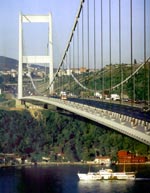 A stay in İstanbul is not complete without a traditional and unforgettable boat excursion up the İstanbul Strait, that winding strait that separates Europe and Asia. Its shores offer a delightful mixture of past and present, grand splendor and simple beauty. Modern hotels stand next to yalı (shore-front wooden villas), marble palaces abut rustic stone fortresses, and elegant compounds neighbor small fishing villages. The best way to see the İstanbul Strait is to board one of the passenger boats that regularly zigzag along the shores. You embark at Eminönü and stop alternately on the Asian and European sides of the strait. The round-trip excursion, very reasonably priced, takes about six hours. If you wish a private voyage, there are agencies that specialize in organizing day or night mini-cruises. A stay in İstanbul is not complete without a traditional and unforgettable boat excursion up the İstanbul Strait, that winding strait that separates Europe and Asia. Its shores offer a delightful mixture of past and present, grand splendor and simple beauty. Modern hotels stand next to yalı (shore-front wooden villas), marble palaces abut rustic stone fortresses, and elegant compounds neighbor small fishing villages. The best way to see the İstanbul Strait is to board one of the passenger boats that regularly zigzag along the shores. You embark at Eminönü and stop alternately on the Asian and European sides of the strait. The round-trip excursion, very reasonably priced, takes about six hours. If you wish a private voyage, there are agencies that specialize in organizing day or night mini-cruises.
During the journey you pass the magnificent Dolmabahçe Palace; farther along rise the green parks and imperial pavilions of the Yıldız Palace. On the coastal edge of the parks stands the Çırağan Palace, refurbished in 1874 by Sultan Abdülaziz, and now restored as a grand hotel. For 300 meters along the İstanbul Strait shore its ornate marble facades reflect the swiftly moving water. At Ortaköy, the next stop, artists gather every Sunday to exhibit their works in a streetside gallery. The variety of people creates a lively scene. Sample a tasty morsel from one of the street vendors. In Ortaköy, there is a church, a mosque and a synagogue that have existed side by side for hundreds of years - a tribute to Turkish tolerance at the grass roots level. Overshadowing İstanbul's traditional architecture is one of the world's largest suspension bridges, the Boğaziçi Bridge, linking Europe and Asia.
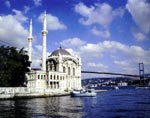 The beautiful Beylerbeyi Palace lies just past the bridge on the Asian side. Behind the palace rises Çamlıca Hill, the highest point in İstanbul. You can also drive here to admire a magnificent panorama of İstanbul as well as the beautiful landscaped gardens. On the opposite shore, the wooden Ottoman villas of Arnavutköy create a contrast with the luxurious modern apartments of neighboring Bebek. A few kilometers farther along stand the fortresses of Rumeli Hisarı and Anadolu Hisarı facing each other across the straits like sentries guarding the city. The Göksu Palace, sometimes known as Küçüksü Palace graces the Asian shore next to the Anadolu Hisarı. The second link between the two continents, is the Fatih Sultan Mehmet Bridge straddles the waterway just past these two fortresses. The beautiful Beylerbeyi Palace lies just past the bridge on the Asian side. Behind the palace rises Çamlıca Hill, the highest point in İstanbul. You can also drive here to admire a magnificent panorama of İstanbul as well as the beautiful landscaped gardens. On the opposite shore, the wooden Ottoman villas of Arnavutköy create a contrast with the luxurious modern apartments of neighboring Bebek. A few kilometers farther along stand the fortresses of Rumeli Hisarı and Anadolu Hisarı facing each other across the straits like sentries guarding the city. The Göksu Palace, sometimes known as Küçüksü Palace graces the Asian shore next to the Anadolu Hisarı. The second link between the two continents, is the Fatih Sultan Mehmet Bridge straddles the waterway just past these two fortresses.From Duatepe Hill, on the European side, you can admire the magnificent panorama of the bridge and the İstanbul Strait. Below Duatepe, the beautiful Emirgan Park bursts with color when its tulips bloom in the spring. On the Asian shore is Kanlıca, a fishing village that is now a favored suburb for wealthy İstanbulites. Crowds gather in the restaurants and cafes along its shores to sample its famous yogurt. Shortly after Kanlıca and Çubuklu is the Beykoz Korusu (İbrahim Paşa Woods), a popular retreat. In the cafes and restaurants there you can enjoy the delightful scenery and clear, fresh air. Back on the European side, at Tarabya Bay, yachts seem to dance at their moorings. The coastal road bustles with taverns and fish restaurants from Tarabya to the charming suburbs of Sarıyer and Büyükdere. Sarıyer has one of the largest fish markets in İstanbul and is also famous for its delicious varieties of milk puddings and börek (pastries). On past Sarıyer, the narrow strait widens and opens into the Black Sea.
Museums and Ancient Cities
Hagia Sophia (Ayasofya) Museum : Ayasofya was built, for nearly a thousand years ago, is the largest enclosed space in the world, and still seen as one of the world’s most important architectural monuments. It is one of Turkey’s most popular attractions, drawn by the sheer spectacle of its size, architecture, mosaics and art.
It used to be a church for 916 years, then a mosque for 481 years, and since 1935 has been a museum. Thought to have been constructed by Emperor Konstantinos I (324 – 337) it was burned down during a revolt. Rebuilt by Emperor Theodosium II, it was opened for worship in 415 and once again was burned to the ground, during the Nika revolts of 532. 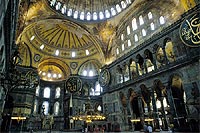 Emperor Iustanianus (527 – 565) wanted to construct something even bigger than the original two and appointed architects Isidoros from Miletos, and Anthemios from Tralles to build the Aya Sofya which still stands. Columns, heads, marble and coloured stones were imported to İstanbul from ancient cities in Anatolia for the purpose. Emperor Iustanianus (527 – 565) wanted to construct something even bigger than the original two and appointed architects Isidoros from Miletos, and Anthemios from Tralles to build the Aya Sofya which still stands. Columns, heads, marble and coloured stones were imported to İstanbul from ancient cities in Anatolia for the purpose. The construction began on 23 December 532, and was completed exactly five years later. The main, central section measured 100m x 70m, covered with a 55m high dome which was a mammoth 30m in diameter – appearing to be a great feat of design. The mosaics are of great importance, and the oldest ones are dominated by geometric and plant motifs decorated with gold. The worst desecration of the church was in 1204, ransacked by Catholic soldiers during the Fourth Crusade. In 1453, after a failure of the Byzantine Church to fend off the Turks, Mehmet the Conqueror captured the city, rode into Aya Sofya and immediately turned it into a mosque. It was repaired several times, and İslamic ornamentation added, for example an extract of the Koran by calligrapher İzzet Efendi inscribed on the dome. The other reminders of its previous status as a mosque include huge wooden plaques bearing the names of Allah, the Prophet Mohammed and the first four caliphs. The marble and mosaics remain the most interesting aspects today. The columns supporting the gallery are made from antique marble, and in the western gallery is the green marble which marks the position of the throne of the Empress. The impressive figurative mosaics include Virgin and Child flanked by two emperors, dating back to the late 10th century, and one depicting Christ, the Virgin, and St John the Baptists. Even though there is partial damage, the haunting images on their faces remain as strong as ever.
Süleymaniye Mosque
RELIGIOUS MONUMENTS
Suleymaniye Mosque
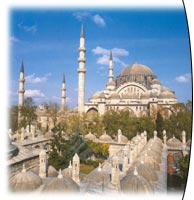 At one's first glance there are two things that are particularly remarkable in the ancient monuments of the Ottomans: the choice of the site and the perfect unity of the whole. Whether or not it is in a ra~sed place, the site always has a view of vast open spaces and however far one may look, one may see the sky. The structure as a whole is broad and imposing. All details of the monument, howev- er charged with multiple ornaments it may be, simultaneously con- tribute to a general effect that is always simple and always unique. At one's first glance there are two things that are particularly remarkable in the ancient monuments of the Ottomans: the choice of the site and the perfect unity of the whole. Whether or not it is in a ra~sed place, the site always has a view of vast open spaces and however far one may look, one may see the sky. The structure as a whole is broad and imposing. All details of the monument, howev- er charged with multiple ornaments it may be, simultaneously con- tribute to a general effect that is always simple and always unique.
İf, fmong all the masterpieces which are imbued with the genius of Master Sinan Master and of his pupils, there is one that fills more perfectly than the others these fundamental conditions of Ottoman architecture, it is undoubtedly the Süleymaniye. Situated at the top of a hill dominating the Kantarcılar district between the Ministry of Wlar and the Office of the Sheikhulislam, the Süleymaniye soars majestically towards the sky with nothing to hinder its ascent. From the vast platform of its enclosure, one captures at a single glance Europe and Asia, the two seas that bathe Istanbul, and the smiling Princes Isles. Further still, in the vaporous transparency of the horizon, the giant Bithynian Olympus takes shape against a pure sky, standing like an ever present witness to the memory of the cradle of ancient Ottoman power. Confronted by such a tableau, the spirit can conceive only noble ideas. Founded in year 964 of the Hegira (1556 of the Christian era) by Sultan Süleyman the Lawgiver, for whom history has also decreed the names of "the Great" and "the Magnificent'; the Süleymaniye is preceded by an interior court or square flanked by four minarets. By this number, according to tradition, the founder wanted to indicate that he was the fourth Ottoman sovereign since the aonquest of Constantinople. In the same way, the total number of the bal conies of its minarets indicates that he was the tenth sultan since Osman Ghazi, the glorious root of his line.
The two minarets located at the two sides of the facade have two balconies each, and the two other two, which are at the other end of the square on each side öf the porch, have three balconies each. The total number, for the four minarets, yields ten balconies, all with corbelling in stalactites. Three beautiful doors whose open- ings are formed of flattened curues are each surmounted by an ogee arch and give access through the frontage and the two other sides of the courtyard. A cloister of twenty four arcades runs around and is supported by an equal number of columns. The pair closest to the door in the facade are of porphyry; of the remainder, twelve columns of pink granite alternate with ten of white marble. All are of the crystallized order. Their capitals are of white marble, and the edges of their stalactites heavily gilded.
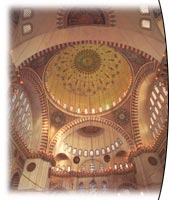 Domes, which number twenty four, surmount the gallery of tbe cloister. Their cupolas are paînted with ornaments and flowers on a ground, and the largest, located midway along the porch, in front of the entrance to the nave, is decorated with pendentives in white marble stalactites, with gilding on the edges of crystalliza- tions. The door of the nave is a niche decorated with stalactites, also fashioned from gilded white marble in a design of great puri- ty and aspect of true monumentality. The proportions are large. Two other smaller niches are located along each side at half the distance between the entrance to the nave and the courtyard wall. The windows of the porch have quadrangular bays surmounted by ogee arches lavishly decorated with glazed tiles that have a royal blue ground on which beautiful Arabic letters are inter.- laced, tracing out in pure white sacred verses from the Quran. Domes, which number twenty four, surmount the gallery of tbe cloister. Their cupolas are paînted with ornaments and flowers on a ground, and the largest, located midway along the porch, in front of the entrance to the nave, is decorated with pendentives in white marble stalactites, with gilding on the edges of crystalliza- tions. The door of the nave is a niche decorated with stalactites, also fashioned from gilded white marble in a design of great puri- ty and aspect of true monumentality. The proportions are large. Two other smaller niches are located along each side at half the distance between the entrance to the nave and the courtyard wall. The windows of the porch have quadrangular bays surmounted by ogee arches lavishly decorated with glazed tiles that have a royal blue ground on which beautiful Arabic letters are inter.- laced, tracing out in pure white sacred verses from the Quran.
A very simple fountain, in the form of a parallelogram with four vertical faces and covered by a zinc roof, occupies the center of the square. Its decoration, sober and gracious, consists of a metal grill painted in emerald green and an openwork lattice of geometrical rosettes, above which runs a frieze of white marble carued with broad leaves whose hearts are slightly tinted aqua- marine. ~ The court is entirely paved with enormous flagstones of white marble, except for the passage which gives access, through the porch, inside the mosque. There, in front of.the main door, is placed a round monolithic flagstone of the richest porphyry with a diameter of approximately two meters. If we should believe a popular legend associated with this flagstone, it marks a tragic event and played a bloody role during the construction of the Süleymaniye courtyard. Sultan Süleyman had himself chosen and indicated a sample of the most precious porphyry with which to enrich, the place before the mihrab inside mosque which indi cates the direction of Mecca towards which the faithful perform ~
their prostrations. He spelled out the particulars of size and finish to a skilful workman who knew the destination of the stone. This craftsman, who was a Christian, thought he would do a pious deed by carving on the flagstone a cross, perhaps hoping that merely by the sight of this emblem, all the Muslims would convert spontaneously. He had undoubtedly not re~l'ected, or perhaps he was unaware, that the Islamic religion absolutely proscribes plâces reserved for the worship of any image. The flagstone of porphyry became, by virtue of the fact that a cross had even been carved on it, unsuitable with the ornamentation of mosque.
Sultan Süleyman, indignant at seeing all his care thus rendered useless, was provoked, they say, into a violent rage. He condemned the workman to death, and ordered that it be carried out then and there, in front of his eyes. T'hey thus brought into the courtyard a throne, on which the sovereign sat down to preside over the execu- tion. The sculptor was decapitated in his presence and to preserue at the same time the memory of this disobedience and its terrible punishment, they carued deeply into the block of the marble where the seat of the sultan had sat and where the head of the victim had fallen, two signs which vaguely represent the outline of a t.hrone and that of a head; they are still to be seen there today. As for the porphyry, flagstone, so that it would not be completely wasted, they turned it over so that the cross was on the bottom and then installed it in front of the principal entrance to the nave with the result that, unbeknownst to themselves, all who pass over it are treading on the cross. It is thus fulfills a function quite contrary to the proselytical intentions of the executed sculptor. Nothing prevents us from believ- ing in this legend, which bears all the attributes characteristic of the truth, for it is known that leniency did not number among the favorite virtues of Sultan Süleyman the Lawgiver. Moreover, at that time, tolerance and mercy were practiced no better in the ~est than th.ey were in the East. Francis I, the restorer of arts and the patron of literature, also had the philosopher and scholar Etienne Dolet publicly burned alive; Charles V formally took part in the "acts of faith" of the Spanish Inquisition.
The Islamic religion, at least, has never had an institution sim- ilar to the Holy Office. Be that as it may, afterpassing over the leg- endary porphyry flagstone, we enter the nave, where we first of all are overcome by our admiration of the lofty and vast cupola of the dome, painted in a wash of clear tones of blue, white, and gold. These three colors form the basis of the entire decorative harmony of the building: its paintings, sculptures, precious marbles, tiles, etc, both inside and out. Everywhere, the white and blue domi- nate-the white especially. A few pink granite and porphyry columns or insets, a few lines the color of blood, freshen the light without interrupting this harmony; the gildings of the stalactites are everywhere applied with a solemnity that does not disturb the tranquility. The colossal vault is supported by four gigantic upright piers. Around the sides are columns that support the lat- eral galleries and the first landing, which contains the loges for the ladies and extends in a square around the nave. Three circu- lar galleries gird the central rotunda. During the nights of Ramazan and on other holy days, splendid illuminations engulf the balustrades which circumscribe them, and highlight all the elegant details of the stars, flowers, foliage, and scrollwork in flame. The first of these gallerie~..is reached by two staircases that are located conveniently close tö the entrance. The two uppergal- leries, the highest of which is at the same level as the great central cupola, is reached by wooden ladders placed on the roof outside the dome. In this last gallery, there is a curious acoustical effect: sounds made anywhere in the interior are concentrated here and even softly-spoken words uttered in the nave or the aisles may be distinctly heard here.
Another curiosity worthy of remark, and which could be pro- posed as an example to architects, is the following one: tunnels dug in the ground and faced with solid masonry, lead from the interior of the mosque to external tanks that are used for the dis- tribution of water to all the dependencies of the Süleymaniye. The famous architect of this mosque, Master Sinan, combined this sup- ply so as to take advantage of it in order to maintain inside the nave a mild and uniform temperature. By means of wooden trap doors that are located all over the central part of the floor of the nave, the air contained in these underground tunnels is fed into the mosque, where, as a result, the temperature is always warm in winter and cool in summer. All the inscriptions that decorate the Süleymaniye were executed by the famous calligrapher Hasan Ç'elebi, who is buried beside his master in Sütlüce by the Sweet T~aters of Europe. Among the outstanding calligraphic ornamen- tation one should particularly mention the large rosettes of glazed tiles adorned with white letters on a royal blue ground and framed by borders of foliage executed in turquoise blue which decorate the two sides of the mihrab. Like thepulpitplaced to its left, the mihrab is made of white marble, cazved in stalactites that are gilded with gold. ?'he marble plates composing the pulpit number only four.~ the gate and base are formed of single slabs and measure eight meters, one in its length and the other in its height. 2'hese are also the measurements of the niche in which the mihrab is set. The imperial loge, situated at the right, is also of white. It is supported by porphyry columns with capitals in the crystallized order that are fashioned of gilded white marble. There are two richly-deco- rated fountains that are intended for ablutions. The door of this loge is, like all the woodwork of the building, engulfed in carved geometric rosettes. A kürsü (pulpit) abutting the pillar closer to the imperial loge is also worthy of mentioning for the remarkable
excecution of work of this last kind, in which walnut has been finely cut with open-work and carved with boldness and delica- cy. At the other end of the nave, on the pillar on the opposite side, the balcony of the muezzin is set. Simpler, but almost as beauti- ful as the imperial loge, it is also of the crystallized order. Behind the muezzin's balcony along the low sides, is located~the library, separated from the nave by a superb screen of brass worked in rococo ornamentation. It was repaired during the reign of Sultan Mahmud I by his grand vizier, Mustafa Pasha. More recently, this screen was renovated by Ahmed Vefik Efendi. .
Leaving the nave, one passes in front of external galleries with superimposed orders: the lower is in the crystallized order and has ogival arcades in which broad and high arches alternate with low and narrow ones, The upper order is planar with a row of reg- ular arcades that are narrow and high. On the side of the mosque which looJzs towards Mecca there are cemeteries planted with rose bushes in the center of which have been erected several splendid tombs among which is that of the mosque's benefactor. Among all these illustrious dead, the architect of Süleymaniye does not appear; instead, Master Sinan built for himself a modest and charming mausoleum, located not far from there, at the intersec- tion of two streets, between the enclosure outside of the mosque and the Office of the Sheikhulislam, which in his day was the headquarters of the Janissaries.
It is known that this great artist was a member of that terrify- ing militia which, after having raised the military might of Turkey to its brightest apogee, then turned and because of its continued mutinies and the bloody tyranny that it exercised over the sover eigns themselves and all their subjects, its abolition became essen- tial for the advancement of the empire. During the entire course of his long and glorious life Master Sinan never ceased to receive the pay and pension due to the haseki ~privy household~ corps of Janissaries. The violent suppression of this turbulent and undisci- plined body, ordered by Sultan Mahmud II, continued until the very tomb leaving no trace nor any emblem that might remind posterity of its odious memory: even the stone turbans that distin- guished the burial places of these eternally proscribed militiamen were broken. In one honorable exception the tomb of Master Sinan was respected, and thus, thanks to the very special indul- gence of the sovereign, one may see still see standing over the slab of white marble, the grandmaster Ottoman architecture, the typi- cal turban of the haseki corps. The principal dependencies of the Süleymaniye are: a special college for the study of the oral tradi- tions of the Prophet; four higher schools (medreses); a prepara- tory college for the sciences; a school of medicine; a primary school; a kitchen and hospice for students; a great public bath; and a very famous asylum for lunatics.
The historian Peçevi (v 1, p 424) says that, according to what was appeared in the accounts of the director of construction, the expenditure for this building amounted to 896,.383 florins, which was worth 53, 782,900 aspers then, of which SO were equivalent' to a gurush. The gurush in the time of Sultan Süleyman is esti- mated by Mr Belin, in the Mecidiye currency to be worth SO pias- tres and 27 paras.
Sultanahmet Mosque
Sultanahmet Mosque
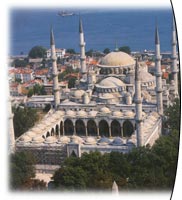 This mosque was built by Sultan Ahmet I during 1609-1616 in the square carrying his name in İstanbul. The architect is Sedefhar Mehmet Ağa. It is the only mosque in Turkey with six minarets. The mosque is 64 x 72 m in dimensions. The central dome is 43 m in height and is 33.4 m in diameter. 260 windows surround the mosque. Due to its beautiful blue, green and white tilings it has been named the "Blue Mosque" by Europeans. The inscriptions were made by Seyyid Kasım Gubari. This mosque was built by Sultan Ahmet I during 1609-1616 in the square carrying his name in İstanbul. The architect is Sedefhar Mehmet Ağa. It is the only mosque in Turkey with six minarets. The mosque is 64 x 72 m in dimensions. The central dome is 43 m in height and is 33.4 m in diameter. 260 windows surround the mosque. Due to its beautiful blue, green and white tilings it has been named the "Blue Mosque" by Europeans. The inscriptions were made by Seyyid Kasım Gubari.Topkapı Palace One of the most astounding and popular places to visit in İstanbul is Topkapı Palace, the symbolic and political centre of the Ottoman Empire in between the 15th and 19th centuries. It stands on the tip of land where the Golden Horn, the Sea of Marmara and the İstanbul strait come together, and is a maze of buildings centered around a series of courtyards, typical of Islamic tradition. Such is the complexity of each building, it will take many hours in order to be explored properly. 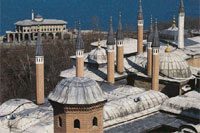 It was built in between 1466 and 1478, a couple of years before the death of Fatih. Unlike any European Palace, its architecture is predominantly Middle Eastern in character. The initial construction was Cinili Mansion, a Glass Palace finished in 1472, and the imposing main gate facing Sultanahmet, Bab-I Humayun, and the Palace ramparts, were completed in 1478. It was built in between 1466 and 1478, a couple of years before the death of Fatih. Unlike any European Palace, its architecture is predominantly Middle Eastern in character. The initial construction was Cinili Mansion, a Glass Palace finished in 1472, and the imposing main gate facing Sultanahmet, Bab-I Humayun, and the Palace ramparts, were completed in 1478. There were originally 750 residents of the Palace, during Fatih’s period, which became drastically more congested reaching 5000 during normal days and 10,000 during festivals. Extensions had to be built, and the harem was completed in 1595 during the third Sultan Murad’s era, after which the harem residents were moved in from the palace at Beyazit, with a total of 474 concubines. Special tours of the Harem are available. The Harem, literally meaning “forbidden” in Arabic, was the suite of apartments in the palace belonging to the wives, concubines and children of the head of the household. Around the Harem there were, Circumcision Room, the apartments of the Chief Black Eunuch, and apartments of the sultan – in total over 400 rooms. Other highlights in the Palace are the Spoonmaker’s Diamond (the fourth largest diamond in the world), the Topkapi Dagger, (a gift from Mahmut I), a vast collection of paintings and miniatures, and the Pavilion of the Holy Mantle (including a footprint, a tooth and a hair of the Prophet Mohammed). Opening hours: Daily 09.00 – 17.00, winter closed Tuesday. Dolmabahçe Palace 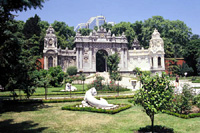 Built in the reign of Sultan I Abdulmecit during the 19th century, this over-ornate palace lies along the European coast of the İstanbul strait. Dolmabahce Palace was constructed in between 1843 and 1856, mixing different European artistic influences and built by Abdulmecit’s architect, Karabet Balya. It was built over three levels, and symmetrically planned, with 285 chambers and 43 halls. It has a 600m long pier along the river, with two huge monumental gates. The palace is surrounded by well-maintained and immaculate gardens, with an immense 56-columned greeting hall, with 750 lights illuminated from 4.5 tonnes of crystal chandelier. The entrance was used for meeting and greeting Sultans, and opposite the ceremonial hall was the harem. The interior decoration, furniture, silk carpets and curtains all remain with little defect. Built in the reign of Sultan I Abdulmecit during the 19th century, this over-ornate palace lies along the European coast of the İstanbul strait. Dolmabahce Palace was constructed in between 1843 and 1856, mixing different European artistic influences and built by Abdulmecit’s architect, Karabet Balya. It was built over three levels, and symmetrically planned, with 285 chambers and 43 halls. It has a 600m long pier along the river, with two huge monumental gates. The palace is surrounded by well-maintained and immaculate gardens, with an immense 56-columned greeting hall, with 750 lights illuminated from 4.5 tonnes of crystal chandelier. The entrance was used for meeting and greeting Sultans, and opposite the ceremonial hall was the harem. The interior decoration, furniture, silk carpets and curtains all remain with little defect. 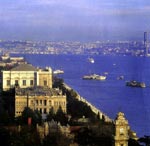 The palace has a level of luxury, which has not presented in most other palaces, with walls and ceilings decorated with gold, and European art from the period. Top quality silk and wool carpets, southeast Asian hand-made artifacts, and crystal candlesticks adorn every room. The men’s hamam (public bath) is adorned with alabaster marble, and the harem also contains the Sultan’s bedrooms and the women and servants’ divisions. One of the highlights is the throne room, which stands at an amazing 36-metres high – almost twice the height of the rest of the rooms. The east wing is home to the Museum of Fine Arts. The palace has a level of luxury, which has not presented in most other palaces, with walls and ceilings decorated with gold, and European art from the period. Top quality silk and wool carpets, southeast Asian hand-made artifacts, and crystal candlesticks adorn every room. The men’s hamam (public bath) is adorned with alabaster marble, and the harem also contains the Sultan’s bedrooms and the women and servants’ divisions. One of the highlights is the throne room, which stands at an amazing 36-metres high – almost twice the height of the rest of the rooms. The east wing is home to the Museum of Fine Arts. Opening hours: Daily 09.00 – 16.00, except Monday and Thursday. Telephone number to book guided tours: (0212) 23 69 600. Detailed Information Çırağan Palace 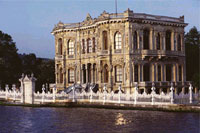 The most picturesque spots along the İstanbul strait and Golden Horn were reserved for the palaces and mansions for the Sultans, and other important dignitaries, most of which have now gone. The huge palace was constructed by architect Serkis Balyan in 1871, as appointed by Sultan Abdul Aziz, from the ruins of the old palace. The most picturesque spots along the İstanbul strait and Golden Horn were reserved for the palaces and mansions for the Sultans, and other important dignitaries, most of which have now gone. The huge palace was constructed by architect Serkis Balyan in 1871, as appointed by Sultan Abdul Aziz, from the ruins of the old palace. The interior construction was rebuilt, at a cost of four million gold coins, beginning with covering the ceiling with wood and the walls with marble. The rooms were decorated with rare carpets, furniture, gold and silver. The sides of the building were decorated with coloured marble, and monumental gates connected it to Yildiz Palace, via a bridge, which is how the harem women went between the two, in total privacy. It briefly housed the Turkish Parliament from 1908, but was destroyed by a fire two years later, and was only rebuilt in 1991. Now, it is İstanbul ’s premier luxury hotel, and has retained something of its former glory. Beylerbeyi Palace 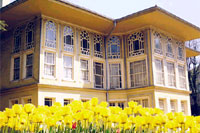 Beylerbeyi, in which the Asian Tower of İstanbul strait Bridge was constructed, is a beautiful district allotted for palaces since the Byzantium era. Sultan Abdulaziz built the Palace, to replace the older, wooden palace, between 1861 and 1865. Eastern and Turkish motifs are used with Western design elements, on the sides and for internal decoration, and the atmosphere is something resembling that of Dolmabahce Palace. Beylerbeyi, in which the Asian Tower of İstanbul strait Bridge was constructed, is a beautiful district allotted for palaces since the Byzantium era. Sultan Abdulaziz built the Palace, to replace the older, wooden palace, between 1861 and 1865. Eastern and Turkish motifs are used with Western design elements, on the sides and for internal decoration, and the atmosphere is something resembling that of Dolmabahce Palace. The building comprises of three floors, and contains 26 rooms and six halls, which includes the harem and men's greeting rooms. The interior is decorated with Bohemian chandeliers, valuable tiles and ceramic vases. Silver-edged furniture and luxurious carpets add something to the beauty, and even till today the authentic furniture, carpets, curtains and other property have been well preserved. A big pool, terraces and stables, face at the back of cliff. A road and tunnel, used until 1970, passed under the palace garden and were used by the most distinguished foreign dignitaries when visiting the palace. Open daily except Monday and Thursday. Detailed Information Yıldız Palace This vast park consists of mansions, gardens and lakes, the whole area surrounded by high walls, and all set in a superb hillside location. Popular at weekends and holidays with locals, it offers one of the few green areas within the city centre, and is a great place for walking, relaxing and eating. There is a steep walk up the hill from Ciragan Caddesi up to the first pavilion, but rewards are cooling breezes and sweeping views of the İstanbul strait. It was in the centre of the Ottoman Empire for 30 years, during the reign of Abdulhamid II, and the second largest palace in İstanbul . The main structure of Yildiz Palace, was built in the old Ottoman style and the pavilions which are dotted around the park were transformed into a power base. The most important remaining building is Sale Koske, where receptions were held, and is the largest and most ornate and reveals the luxury in which the sultans lived and entertained. The first section was modelled on a Swiss Chalet, the second two completed in the late 19th century. Some of the mansions are undergoing restoration, but Sale is open for visitors, and two have terraces serving food and drinks. Further along the path is a State museum, the Belediye Sehir Muzesi, and Yildiz Sarayi Theatre. Park: Open daily 09.00 – 17.30 Sale Köşkü : Open daily 09.30 – 17.00, except Monday and Thursday. Museum: Open daily 09.00 – 16.30, except Monday. Detailed Information Yıldız Porcelain Factory Detailed Information Küçüksu Small Palace: Built by Abdulmecit I in the mid-19th century, it was used as a summer residence. Closed Mondays and Thursdays. Aynalıkavak Summer Pavilion : Built in the early 18th century and later restored by various sultans, this timber royal pavilion is in the Hasksoy district, on the Karakoy side of the Golden Horn, incongruously placed between a naval dockyard and cemetery. The last surviving structure of a large group of buildings, the pavilion is famous for its mirrors, hence its Mirrored Poplar, which were gifts from the Venetians and installed in 1718. One of the most beautiful examples of traditional Ottoman architecture, the composition room, a private room of Ahmet III where he used to compose music, includes a central brazier and low divans - typical interior of the era. The pavilion, most recently restored in 2000, also has exhibition of old Turkish musical instruments. The windows facing the sea are decorated with stained glass. Opening hours: 09.00 - 16.00, closed Mondays and Thursdays. Çinili Köşk (Tiled Pavilion) : The oldest secular building İstanbul , this was constructed as a mansion in 1472. It was a type of grandstand from which the Sultan would sit and watch wrestling or polo, and its interior is beautifully decorated with Selcuk art. It now houses the Museum of Turkish Ceramics, containing fine example of 16th century tiles from Iznik, as well as other renowned examples of art and pottery from Selcuk and Ottoman times. Closed Mondays. Ihlamur Köşkü : The 19th-century Ihlamur Pavilion is named after the linden trees growing in its gardens. Although now in the heart of metropolitan İstanbul , when it was originally constructed, the pavilion lay in the rolling countryside that surrounded the city. The Merasim Pavilion:This was used for official ceremonies while the Maiyet Pavilion sheltered the sultan's entourage and, on occasions, his harem on their excursions out of the palace confines. Closed on Mondays and Thursdays. Detailed Information Maslak Pavilion : Maslak Pavilions, situated on a shady green hill, were conceived by Sultan Abdulaziz as hunting lodges. These are particularly noteworthy as superb examples of the late 19th century Ottoman decorative style. Closed Mondays and Thursdays. Detailed Information Florya Atatürk Sea Pavilion : The Florya Ataturk Sea Pavilion served as a summer residence for Turkish presidents, beginning with Atatürk. Built in 1935 in a T-shaped design on land jutting out over the Sea of Marmara, it serves as a showcase for some of the finest examples of early-20th century furnishings. Closed Mondays and Thursdays. Detailed Information Filizi Mansion Detailed Information Hereke Silk Fabric and Carpet Factory Detailed Information Yalova Atatürk Mansions Detailed Information Tekfur Palace Detailed Information Religious Monuments 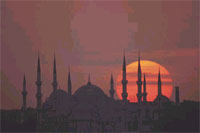 Sultanahmet Mosque, Süleymaniye Mosque, Rüstem Paşa Mosque, Fatih Mosque, Eyüp Mosque, Yeni Mosque, Sokullu Mehmet Paşa Mosque and Mihrimah Sultan Mosque are amongst the most famous places of interest. Sultanahmet Mosque, Süleymaniye Mosque, Rüstem Paşa Mosque, Fatih Mosque, Eyüp Mosque, Yeni Mosque, Sokullu Mehmet Paşa Mosque and Mihrimah Sultan Mosque are amongst the most famous places of interest. There are many churches and monasteries active within the city, some of which have been turned into mosques. Studios Monastery Church, Sergios-Bakhos Church, Hagia Eirene Church, Pantakrator Monastery Church, Vefa Church (Hagios Theoderos), Nyrelaion Monastery Church, Eglise D'hagia Thekla Monastery, Eski Imaret Mosque (Pantepoptes Monastery Church), Kalenderhane Mosque (Akataleotos Monastery), Fenari Isa Mosque (Lios Monastery Church) and Fethiye Mosque (Pammakaristos Monastery Church) are the best-known ones. Ramparts 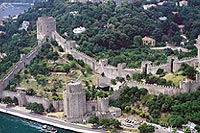 City Walls : The location of old İstanbul is marked in a triangular shape by the 6½ km-long city wall, called Theodosius II city walls, which started construction in 413. An earthquake in 447 almost destroyed them, so were rebuilt in a hasty two months. The mammoth effort was thanks to 16,000 citizens who were forced to work to get it completed in time to prevent Attila’s forces who were fast advancing. They completed construction of the original walls, 5m thick and 12m high, plus and outer wall of 2m by 8.5m, and a moat. Since 1990, some areas have been rebuilt, and some unrestored areas collapsed during the 1999 earthquake. It is possible to walk along the entire length, which would take a full day, with highlights including Yedikule, Edirnekapi and Mihrimah Camii. City Walls : The location of old İstanbul is marked in a triangular shape by the 6½ km-long city wall, called Theodosius II city walls, which started construction in 413. An earthquake in 447 almost destroyed them, so were rebuilt in a hasty two months. The mammoth effort was thanks to 16,000 citizens who were forced to work to get it completed in time to prevent Attila’s forces who were fast advancing. They completed construction of the original walls, 5m thick and 12m high, plus and outer wall of 2m by 8.5m, and a moat. Since 1990, some areas have been rebuilt, and some unrestored areas collapsed during the 1999 earthquake. It is possible to walk along the entire length, which would take a full day, with highlights including Yedikule, Edirnekapi and Mihrimah Camii. At the southern point of the walls is Yedikule and the Golden Gate, the most impressive within the walls. The area is an old, attractive quarter with many churches, since this is the centre of Rum Orthodoxy, the last remaining descendants of the Byzantine Greeks. The Gate is flanked by two marble towers, a monumental entrance through which important state visitors and triumphant emperors would pass through. The gold-plated doors were removed after the collapse of the empire and the entrance bricked up, although the three arches are still visible. The other five towers were added by Mehmet the Conqueror, and together with the 12m wall it forms the enclave which can be seen today. Two of the towers were prisons, and the one in the second tower was also an execution chamber. The wooden gallows and the well into which the heads would roll, are still visible today, as are some instruments of torture. While the entire enclave was used as a treasury, warehouse and ambassadorial jail, now it is a museum, still with the Golden Gate towers and in the summer months, concerts performed here. Anadoluhisarı and Rumelihisarı : On the Asian side of the İstanbul strait, Anadolu Hisari is a small castle built during the 1390s by Sultan Beyazit. Together with Rumeli, on the European side built by Mehmet the Conqueror in 1452, the two fortresses had complete control of passing transport between the Black Sea and the Marmara. Rumeli, an early Ottoman fortress built in only four months, before the Ottoman conquest of the city, to prevent the aides of Byzantine from the north. Anadolu is always open to explore the walls, and Rumeli has a small open-air theatre showing concerts and plays in summer. There is also a café perched on the top, a popular place in summer evenings for tea, served from great samovars, and light meals. Both fortresses have, of course, a great panoramic view of the İstanbul strait. Bedestens Shopping in istanbul is often a big part of any visit, and the city’s famous historical bazaars offer a wonderful insight into city life. Whether shopping for carpets, spices, vegetables or clothes, the process of making your purchase is likely to be enhanced by the atmosphere of wandering through the crowded stalls - and of course haggling. As usual when bargaining with persuasive shop owners, have an idea of a good price before you start. 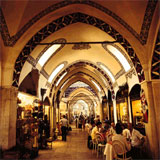 Kapalı Çarşı (Covered Bazaar) : It is the oldest and biggest closed bazaar in the world, also known as the Grand Bazaar, has around 4000 shops and over 60 alleyway, covering a huge labyrinth in the city centre. The original two structures, covered with a series of domes and remains of the 15th century walls, became a shopping area by covering the surrounding streets and adding to it over the following centuries. In Ottoman times this was the centre of trading, and a vital area of town. The Sandal Bedesten was added during Süleyman’s reign, to cope with the rising trade in fabrics, during the 16th century. Kapalı Çarşı (Covered Bazaar) : It is the oldest and biggest closed bazaar in the world, also known as the Grand Bazaar, has around 4000 shops and over 60 alleyway, covering a huge labyrinth in the city centre. The original two structures, covered with a series of domes and remains of the 15th century walls, became a shopping area by covering the surrounding streets and adding to it over the following centuries. In Ottoman times this was the centre of trading, and a vital area of town. The Sandal Bedesten was added during Süleyman’s reign, to cope with the rising trade in fabrics, during the 16th century.Traditionally the more valuable goods were in the old central area, called Ic Bedesten, because it was more secure. As quite typical of the area, most streets are laid out and devoted to a particular trade, for example gold on Kuyumcular Caddesi, leather on Bodrum Han, and shoes on Kavaflar Sokak. But the trade has also spilled out onto the surrounding streets, and it is very common to see Russian traders buying up huge sacks of leather jackets or shoes outside the main entrance. Even the streets leading to the Golden Horn are lined with outdoor stalls, which have traditionally been controlled by strict trading laws to reduce competition between traders. Apart from the usual shops selling clothes, textiles, jewellry and carpets, there are small workshops, where craftsmen cast and beat silver or brass, in a skilled trade handed down through the generations. If all that shopping, bargaining and fending off persuasive salesmen is a little too tiring, there are also traditional cafes dotted inside the bazaar in which to relax, eat and sip tea. There are also money-changing booths inside and out. It is slightly less crowded during weekdays, as most locals shop at weekends. Mısır Çarşısı (Egyptian Bazaar) : Also known as the Spice Market, this is Istanbul’s second bazaar, constructed in the same complex as Yeni Camii (or New Mosque). There are six gates, which make it an attractive exterior. The L-shaped market, together with the mosque, were built for the mother of Mehmet IV, a powerful woman who ruled the harem and, some would say, much of the empire. Although no longer the prime spice trading area of the city, there is still the aroma of ginger, cardamom, pepper and saffron from the piles of spices sold from many stalls. These days it is also popular for great varieties of lokum (turkish delight), small souvenirs, flavoured teas and local delicacies – including the dubious sounding “Turkish Viagra”. Locals come here to shop for bed linen and towels, as well as for fruit and vegetables, coffee, clothes, pots and pans in the surrounding cramped backstreets. Outside the market on the Galata Bridge end, is this is the best place to choose olives from huge barrels, and many varieties of beyaz penir (white cheese). Bakırcılar (Copper Smiths) : Bazaar Lesser known and smaller, but nonetheless just as interesting is this market in Beyazit, under the north and east walls of Istanbul University. Copper is beaten and produced into many shapes, sizes and forms, and shops sell cauldrons, saucepans, buckets, candlesticks and the like. Bit Pazarları (Flea Markets) : Away from the classical, historical markets which have always attracted by the tourists, there are many flea and street markets around the city, usually consisting of streets of junk shops. As usual, getting a real quality bargain is often down to luck, but it is still an interesting way to shop. Çukurcuma Sokak is the central point of streets of shops selling old wooden furniture, antiques, and books, near the Galatasaray Hamam off istiklal Caddesi. üsküdar’s Bit Pazarı is on Büyük Hama Sokak, and in Kadıköy, Ozelli Sokak sells mainly furniture. Horhor market, behind Aksaray mosque, is famous for antiques, selling rare Ottoman furniture. The Entel, or Intellectual Market in Ortaköy sells arts, craft and antiques, music cassettes and books, and is open every Sunday and usually very crowded. Beşiktaş Pazar is open every Sunday, a warren of streets near Sair Nedim Caddesi, sells bargain clothes. Terkoz Cikmaz, next to the Paşabahçe glass store off istiklal Caddesi, has bargain designer clothes, factory seconds or overruns from France, England and Germany at rock-bottom prices. Sahaflar Carşısı is near a flea market, and specialises in second hand books. Towers
National and Natural Parks
NATURE PARKS
Istanbul - Polonezköy
Location: Polenezkoy is in the Beykoz district of Istanbul, in the Marmara Region. Transportation: There is no public transport to the village of Polonezkoy, but private vehicles can access the area from the centre of İstanbul towards the coast, on the Asian side. Highlights: Polonezköy, although still within Istanbul, is 25 km away from the centre and not easy to reach by public transport. Translated as “village of the Poles”, it was established in 1848 by the exiled Prince Czartorisky, a Polish leader, who formed a community of Balkans on land sold to him by a local monastery. The Poles have since left the village, but there are sill a few remaining Central European style wooden houses with pretty balconies. Polonezköy is within a vast green expanse, which was designated Istanbul’s first national park, and many people come to walk though forests with streams and wooden bridges. Its main species of trees include hornbeam, elm, alder, chestnut and lime. Species of wildlife in the park are mainly birds, especially storks and birds of prey that migrate here in the autumn. Facililities: There are good hotels and many restaurants in the village, most of which specialise in Polish cuisine.
NATURE PARKS
Location: Türkmenbaşı Park is in the Sisli area of İstanbul, north of Taksim. Until 1999 it was known as Haciosman Park. Transportation: Sisli can easily be accessed by public transport from Taksim, Eminönü and Mecidyekoy. Highlights: There are many similarities between Türkmenbaşı Park and the nearby Belgrade Forest, both of which are good spots for relaxation and recreation away from city life. It is especially popular for walking and picnicking and its cool shady areas busy during weekends. The road leading to the park is filled with food sellers. The main species of trees are shore pine, black pine and oak. Animals inhabiting the area include jackals, wild boar, reptiles and a variety of birds. The winters can be very cold and cloudy and the area is often covered with snow, whereas summers are hot and dry with threats of droughts. It was granted the status of Natural Park in order to preserve the ecological balance, and to try and control urban development.
Recreation Areas
Islands, Yıldız Park, Emirgan Grove, Gülhane Park, Bosporus, Strait, Belgrad Forest, Atatürk Forest, Çamlıca, Taşdelen, Beykoz Meadow, Karakulak, Polonezköy, Küçük and Büyükçekmece Lakes, Kumburgaz, Kilyos, Piyerloti Coffee House and Şile are the recreation areas and recommonded to be seen.
Polonezköy Beaches There are beaches in Büyükada, Beykoz, Poyrazköy, Kilyos and Sarıyer.
Sports Activities
Camp - Caravan : There are sites available in Silivri, Büyükçekmece, Küçükçekmece, Florya, Ataköy, Bakırköy, Kilyos and Şile.
Hunt Tourism : The main areas for hunting are Bakırköy, Çatalca, Beykoz and Şile. Foreigners can only hunt in parties organised by Turkish travel agencies which have been authorised by the Ministry of Agriculture and Rural Affairs. These agencies provide all information concerning seasons, authorised zones, permits, weapons and ammunition. A list of agencies can be obtained from the Union of Travel Agencies (TURSAB). For more information, contact;
- Forest Ministry, National Parks and Wildlife General Directorate, Gazi Tesisleri No 11, Gazi, Ankara.
Youth and Sport General Directorate, Hunting and Marksman Federation Ulus İşhanı A Blok 4 Kat No 404, Ulus, Ankara. Around Küçükçekmece there are rare ducks and wild geese. Alibeyköy Dam lake also has ducks and geese, and in the hunting areas of Belgrade Forest around Kemerburgaz there are wild boar, foxes, rare jackals and wolves. In the dense forest areas, woodcock, pheasants and wild pigeons are found. Çatalca is the best hunting area in the city, and Yalıköy is a pheasant production area. Binkılıç and its surroundings have wild boar, woodcock wild pigeon, rabbits and foxes. In the higher regions of the Istranca Mountains, it is possible to catch a rare sighting of a wolf in the dense forest. Quail and freckle-partridge hunting can be done in the open expanses of the plains, or between the southern areas of the forests. Water buffalo, which get separated from their herds and become wild within the forest, and now rarely seen, may be hunted with the permission of the Borough Master. Calm waters and municipal lakes are good areas for hunting ducks and wild geese, as well as small rivers and lakes. In the southern provincial areas of the city; quails, stoke doves, freckle partridges, rabbits and foxes are hunted. Further north in the forests are wild boar and woodcocks. The Sinekly region has been determined as a pheasant protection area. In the northeast part of Beykoz, woodcocks, rabbits and foxes are hunted, as well as the rare mountain partridge. Around Omerli Dam lake there are ducks and geese for hunting, and the dense forest areas have wild boar. The Asian side is the best hunting ground in the city, and the forests on the Black Sea coast, especially around Sile, are good for wild boar and woodcock. During migration season, its surrounding river and small lakes, Rez and Riva, have wild geese and wild ducks. Yachting : İstanbul is a popular starting point for yachting, and sailors can reach the Black Sea harbours, İstanbul Straits and Marinas via the European channel system, and the Rhine and Tuna with the European internal seas from the North Sea, and may reach Turkish Mediterranean coasts and marinas. The beautiful bays of the islands and the İstanbul Strait, especially around the two bridges which joins the two continents, are also preferred routes. Marinas Golf : There are two golf courses in the city with licenses from the Ministry of Culture and Tourism: Klassis Golf and Country Club Address: Seymen Koyu, 34930 Silivri,İstanbul Kemer Golf and Country Club Address: Göktur Koyu Uzun Kemer Mevkii, Kemerburgaz, İstanbul.
History
|
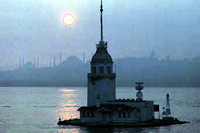 Kız Kulesi : Considered to be a symbol of Istanbul, this tiny tower was established on a small island at the entrance of the Bosphorus. In the past, it was used as a watchtower and a lighthouse, until its present purpose of a tourist attraction. Western sources describe this as Leander’s Tower, who was drowned while swimming, to reach his lover Hera. Another story suggests that it was a tower where an emperor’s daughter put her in there for security, having dreamt that she would be bitten by a snake.
Kız Kulesi : Considered to be a symbol of Istanbul, this tiny tower was established on a small island at the entrance of the Bosphorus. In the past, it was used as a watchtower and a lighthouse, until its present purpose of a tourist attraction. Western sources describe this as Leander’s Tower, who was drowned while swimming, to reach his lover Hera. Another story suggests that it was a tower where an emperor’s daughter put her in there for security, having dreamt that she would be bitten by a snake.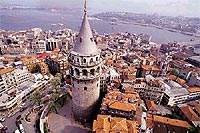 Galata Tower : The tower was built by the Genoese in 1348, during their occupation of the area, primarily to prevent attacks. Originally known as the Tower of Christ, it stood above the fortification surrounding the Genoese city-state. There is a spiral rock staircase which ascends to the top viewing platform, which today offers visitors spectacular 360 degree panorama of the entire city. The tower was restored in 1967, and an elevator was installed to offer a less tiring alternative to the steep climb. There is also a restaurant on the top floor.
Galata Tower : The tower was built by the Genoese in 1348, during their occupation of the area, primarily to prevent attacks. Originally known as the Tower of Christ, it stood above the fortification surrounding the Genoese city-state. There is a spiral rock staircase which ascends to the top viewing platform, which today offers visitors spectacular 360 degree panorama of the entire city. The tower was restored in 1967, and an elevator was installed to offer a less tiring alternative to the steep climb. There is also a restaurant on the top floor.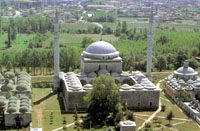
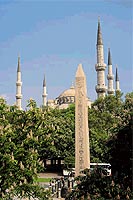
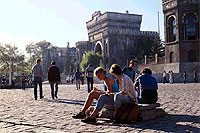 Beyazıt Square : When constructed in 393 AD during the reign of Emperor Theodosius, it was the biggest square in the city. Originally named as Form Tauri, die to the bronze bull heads in the victory cases in the middle, today only a few marble blocks and columns remain, on which the statue of the Emperor rises. At the north end was the first palace constructed by Fatih, and is now Istanbul University. The monumental gate at the university’s entrance, and the fire tower, date back to the 19th century.
Beyazıt Square : When constructed in 393 AD during the reign of Emperor Theodosius, it was the biggest square in the city. Originally named as Form Tauri, die to the bronze bull heads in the victory cases in the middle, today only a few marble blocks and columns remain, on which the statue of the Emperor rises. At the north end was the first palace constructed by Fatih, and is now Istanbul University. The monumental gate at the university’s entrance, and the fire tower, date back to the 19th century.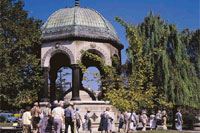
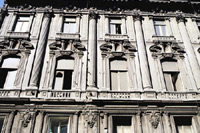 The city has been conquered, fought over and rebuilt many times over the centuries. İstanbul ’s history dates back to the first settlement possibly in the 13th Century BC, although was founded by Byzas the Megarian in the 7th Century BC, from when the city was named Byzantium. A small colony of Greeks inhabited the area until 3rd Century BC, and over the next 1000 years became a thriving trading and commercial centre. Whilst continuing life as a trading city during the Roman Empire, it was then conquered by Emperor Septimus Severius in 193 AD.
The city has been conquered, fought over and rebuilt many times over the centuries. İstanbul ’s history dates back to the first settlement possibly in the 13th Century BC, although was founded by Byzas the Megarian in the 7th Century BC, from when the city was named Byzantium. A small colony of Greeks inhabited the area until 3rd Century BC, and over the next 1000 years became a thriving trading and commercial centre. Whilst continuing life as a trading city during the Roman Empire, it was then conquered by Emperor Septimus Severius in 193 AD.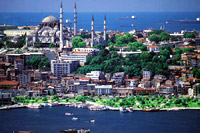
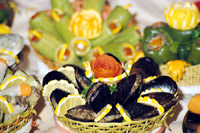
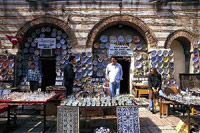
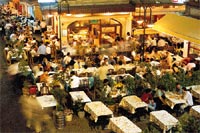 -
-
No comments:
Post a Comment